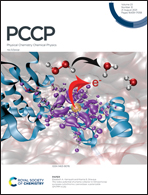Photophysical properties of 1,2,3,4,5-pentaarylcyclopentadienyl–hydrotris(indazolyl)borate ruthenium(ii) complexes†
Abstract
The photophysical properties of heteroleptic rotor-like Ru(II) complexes containing both a cyclopentadienyl-type ligand and a hydrotris(indazolyl)borate chelating unit with a piano stool structure (Ar5L1-Ru-S1 and L3-Ru-S1) and their corresponding subunits have been investigated. The complexes show peculiar absorption features when compared with their related ligands or fragments. L3-Ru-S1 was found to be non-emissive, while Ar5L1-Ru-S1 showed a weak emission with a quantum yield of 0.27%. With the help of DFT calculations, we demonstrate that the new absorption features can be attributed to ruthenium-based charge transfer transitions which involve the π* orbitals of the phenyl substituents of the cyclopentadienyl ligand.



 Please wait while we load your content...
Please wait while we load your content...